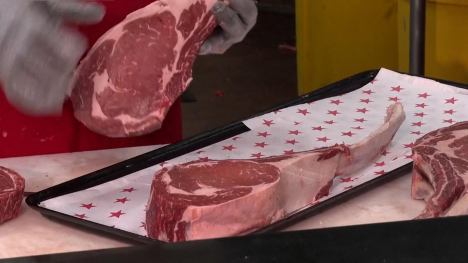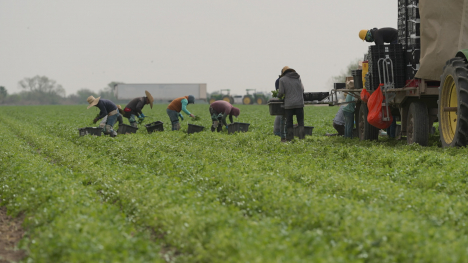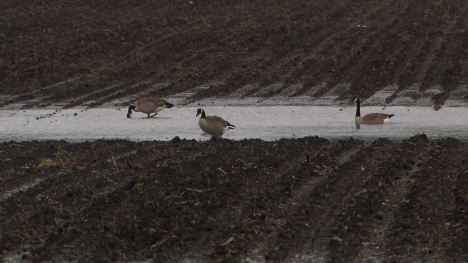
Role of Government In Agriculture
From pork bellies to cow's milk, biofuels to king corn, billions of dollars move through the United States' agricultural marketplace each year. In each step from the farm to the market, there is a framework of national, state, and local government policies. Government may influence what a farmer grows, where a farm is located, how products are transported and processed, how a commodity is traded, and the price the farmer might receive.
What role do you think the government should have in agriculture?
Pagination
- Page 1
- Next page
Background
From pork bellies to cow's milk, biofuels to king corn, billions of dollars move through the United States' agricultural marketplace each year. In each step from the farm to the market, there is a framework of national, state, and local government policies. Government may influence what a farmer grows, where a farm is located, how products are transported and processed, how a commodity is traded, the price the farmer might receive, and more.
Government policy and agricultural productivity have been connected ever since 1799, when President George Washington called on Congress to establish a National Agriculture Board. In 1862, President Abraham Lincoln signed an act of Congress establishing the United States Department of Agriculture (USDA). Lincoln recognized the potential of America's farmers to find new ways to cultivate the land with advances in research and technology, allowing them to provide a safe and abundant food supply. And in what would be his final annual message to Congress, Lincoln dubbed USDA, "The People's Department."
The USDA is the primary agency that promotes, regulates and enforces government policy in the American farm and food industries. Its primary mission is to implement policies approved by Congress every five years in what is commonly known to as "the farm bill." This legislation authorizes federal spending on farm subsidies, food and nutrition programs, rural development initiatives, trade programs, farm credit regulations, conservation plans, market support and more.
USDA, however, is not the only branch of the federal government influencing the agricultural sector. The U.S. Food and Drug Administration (FDA) has jurisdiction over how some foods are handled, prepared and stored. It was created in response to Upton Sinclair's book "The Jungle" which exposed practices and working conditions in Chicago meatpacking plants at the turn of the 20th century.
The Environmental Protection Agency (EPA) enforces laws relating to air and water quality. Regulation of chemical application on American farmland and the amounts of pollutants allowed in local waterways falls under the purview of the EPA. The agency also is charged with implementing the Renewable Fuel Standard (RFS) which dictates how much biofuels, like corn-based ethanol and biodiesel, must be used in the national fuel supply.
Other federal agencies provide funding for scientific research, incentives for renewable energy, transportation infrastructure, and more. Federal policies impacting the domestic economy, foreign affairs, and trade initiates all can have a significant impact on the agricultural sector.
At the state level, government agencies promote local agricultural products, provide food safety and inspection services, soil conservation and environmental protection. State policies regulate the production, transportation, processing, and marketing of commodities. Many state-funded universities and community colleges provide agricultural education, research and extension services important to the health of the industry.
At the local level, county and municipal governments promote agricultural education in schools and through civic organizations. They also regulate the size of farming operations permitted in their respective communities, and approve laws related to farmers' markets, community gardens, and food assistance programs.
At all levels, government influence on agriculture is often the center of debate. Government policies must balance the costs and benefits to farmers, consumers, the environment, government budgets, and competing interests. What role do you think the government should have in agriculture?
Discovery Questions
- What are the steps necessary for a piece of legislation to become a law?
- What current federal, state and local policies impact your life?
- What kind of long-term impacts can a government policy have on a business or industry?
- There are many competing interests in agriculture. What role do you think the government should play in balancing these interests?
- What role do you think the government should take in promoting agriculture products and services to the general public?
- How can you take an active role in advocating for a specific change in government policy?
- When advocating for policies, what kind of information/research do you need to acquire?
Challenge: The Role of Government in Agriculture
View and Print the Challenge | View and Print the Challenge Rubric
Government today may influence what a farmer produces, where a farm is located, how products are transported and processed, how a commodity is traded, the price the farmer might receive, and more. At the national, state, and local level, government influence on agriculture is often the center of debate. Government policies must balance the costs and benefits to farmers, consumers, the environment, government budgets, and other competing interests. Your challenge is to identify an agriculture-related business and examine how it is influenced by government policies. Follow the process below as you consider the impact.
-
Choose an Agriculture Business
Select an agricultural-related business that you would like to pursue as a career. This business might be in production agriculture, transportation, retail, agricultural processing, or another related field. Describe your choice. Include the type of business, what it does, where it is located, and other details you think are important. -
Identify Connections
How are government policies, laws or programs connected to your business? Select at least three policies that you believe are connected to the business you chose. Here are a few examples:- International trade regulation
- Crop subsidies
- Renewable energy subsidies
- Environmental protection
- Wage and hour laws including minimum wage mandates
- Immigration policy
- Government-supported scientific research
-
Consider the Impact
How might the policies you have identified affect the business positively or negatively? Why? Provide detailed examples of how you think each policy might affect your business. -
Analyze a Policy
Consider one single governmental policy that you identified and conduct additional research. Learn more details about the policy and how it came to be. Summarize your findings in a report addressing the following questions:- What is the history of this policy? Which individual or agency makes the policy? What is the reason the policy was created?
- What are other stakeholders of this policy? What is the impact of the policy on these stakeholders?
- Imagine if the government policy you selected was not in place. What impact might that have on your business?
- Evaluate the policy. Do you think it is effective and does it solve a problem? Do you think there is a better solution? Explain your answer, and back up your opinion with evidence.
Related Resources
- Mixed signals: Why is the USDA Promoting Nutrition and Pushing Cheese?
Explore the complex relationship between the U.S. Department of Agriculture and the USDA. PBSLearningMedia, Need to Know - USDA Programs and Services
Review the many varied programs and services offered by the USDA. USDA - Guide to Law Online
Want to know more about the laws that impact agriculture in your state? This comprehensive site provides links to state-level websites for each branch of your state's government. Library of Congress.
Teacher Notes
Module Overview
The Role of Government in Agriculture module outlines the relationship among government agencies, policies and the agricultural marketplace. It describes the role and tasks undertaken by major federal agencies, as well as state and local levels and notes that there is much debate around the question of government influence on the agricultural marketplace.
This module introduces students to several big ideas. In the early 20th century, the U.S. government established several policies and programs regulating and supporting agriculture. Government involvement can be influenced by global issues, trade, economics, politics and other factors. Government programs and policies can result in actions such as tariffs, subsidies, environmental protection, and support for renewable energy. Some of these programs and policies may be controversial.
Learning Goals
This module connects with the following learning goals:
- Explain the role of government in multiple facets of agriculture including production, processing and retail.
- Discuss domestic and international laws and regulations associated with production agriculture.
- Analyze the impact of domestic and international law and regulations on agricultural businesses.
View and Print the Challenge | View and Print the Challenge Rubric





